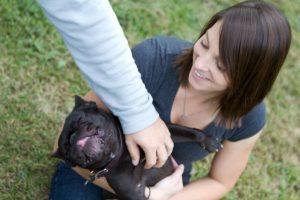 By Allison Arthur, GPG Blogger/Volunteer
By Allison Arthur, GPG Blogger/Volunteer
As the U.S. struggles with a rising obesity rate, research has shown that this problem has been passed on to our domestic pets. Did you know that 54 percent of all dogs and cats in the U.S. are overweight, and 21 percent are obese?
Obesity in animals can cause many problems, including kidney disease, cancer, diabetes and heart disease. A pet’s life expectancy can even decrease. As we all love our animals and want them to live healthy, long lives, it’s time to extend a favorite New Year’s resolution to our pets.
Check out these tips on getting your favorite furry friend into shape:
1. Evaluate What Your Pet Eats
Everyone has an opinion on what and how pets should be fed – dry food, wet food, raw food, etc. I’m not going to delve into that. Let’s focus on the obvious – do you feed your pet scraps from the table? What are you giving them?
I admit it – I feed my dog human food all the time, but I try to keep in mind that what’s bad for me is probably absolutely terrible for her. Therefore, I try to stick to basics – turkey bacon and grilled (unseasoned) chicken.
The same goes for treats! We all love to spoil our furbabies, so it’s difficult to see we’re doing more harm than good sometimes. Research the kind of treats you’re giving your dog or cat. How many calories are in each treat? What is its nutritional value?
Remember, everything is okay in moderation! That brings me to my next tip:
2. Assess How Much Your Pet Eats Even the healthiest pet food and treats are bad for your dog or cat if they are given too often. My dog loves to go in and out all day, which is fine by me – all I have to do is let her run around in the backyard until she’s tired and comes to the door. However, she expects a treat each time she comes in. I’ve found ways around this, breaking her treats up into much smaller pieces, for example. Because I do this, I rarely give her treats at any other time.
Even the healthiest pet food and treats are bad for your dog or cat if they are given too often. My dog loves to go in and out all day, which is fine by me – all I have to do is let her run around in the backyard until she’s tired and comes to the door. However, she expects a treat each time she comes in. I’ve found ways around this, breaking her treats up into much smaller pieces, for example. Because I do this, I rarely give her treats at any other time.
How much food do you feed your cat or dog? The serving samples are on the back of the bag or can for a reason. Figure out a healthy weight for your pet and how much they should be eating based on that weight. Then slowly start feeding your dog or cat less until you’ve reached that serving size.
To evaluate how often you’re feeding your dog, keep a food journal for your dog. This daily log will help you determine where you can cut treats or table scraps. Be honest! It’s for your pet’s own good.
3. Focus on regular exercise
On average, a household pet needs 30 minutes of exercise every day. For a dog that means a couple of short walks or a fun trip to a dog park. Even better, bring your dog along when you go outside to exercise. Dogs make excellent running and speed- walking partners. You can focus on fitness together! If you need more ideas, check out my post from last September on exercising with your pooch.
Cats are a bit more difficult when it comes to exercise. Their stubborn nature doesn’t make it any easier! That means their exercise has to be fun and mind-
stimulating, a few short games with cat nip, for example. This adorable cat from Virginia swims for fitness!
Pet obesity is a huge problem that won’t go away overnight. Follow these tips, and take it slow. Your dog or cat will get healthier every day, and eventually, will reach his or her target weight!
Unsure if your pet’s overweight? Check out this Pet Weight Translator.
Visit the Association for Pet Obesity Prevention website for more information.
[spacer height=”15px”][divider][spacer height=”15px”]
[alert type=”warning” color=”#888″ show_close=”true”]Back to Gateway Pet Gazette Front Page. Click here for more stories.[/alert]
[divider]
